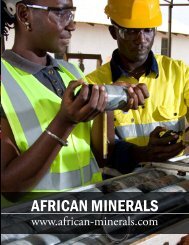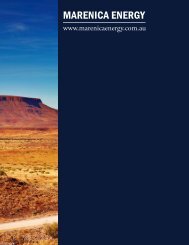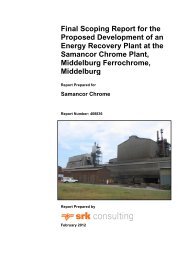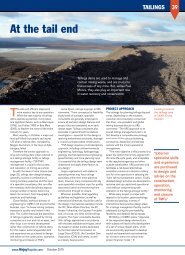Draft Status Quo Report for the Pixley Ka Seme ... - SRK Consulting
Draft Status Quo Report for the Pixley Ka Seme ... - SRK Consulting
Draft Status Quo Report for the Pixley Ka Seme ... - SRK Consulting
Create successful ePaper yourself
Turn your PDF publications into a flip-book with our unique Google optimized e-Paper software.
<strong>SRK</strong> <strong>Consulting</strong> in association with BKS<br />
<strong>Pixley</strong> <strong>Ka</strong> <strong>Seme</strong> Local Municipality EMF – <strong>Draft</strong> <strong>Status</strong> <strong>Quo</strong> <strong>Report</strong> Page 36<br />
Agriculture generates downstream and upstream<br />
employment, including through processing and<br />
transport of produce.<br />
PKSLM is located near South Africa’s major markets<br />
with Gauteng <strong>the</strong> largest market, being less than 300 km<br />
away. Maize is <strong>the</strong> most traded product, with prices<br />
being fixed by SAFEX. AFGRI is one of <strong>the</strong> largest<br />
buyers although many farmers use a portion of <strong>the</strong>ir<br />
crop <strong>for</strong> animal feed.<br />
Agricultural potential<br />
Land capability throughout <strong>the</strong> study area is relatively<br />
high. This is contributed to by quite high average<br />
rainfall (710 mm) which increases from <strong>the</strong> west to<br />
eastern pasts of PKSLM. The moderate slope class <strong>for</strong><br />
most of <strong>the</strong> region is conducive to agriculture, although<br />
in <strong>the</strong> east and sou<strong>the</strong>ast <strong>the</strong> steep topography results in<br />
extreme cold and frost during winter.<br />
The three WMAs provide opportunity <strong>for</strong> irrigation, and<br />
numerous farms in PKSLM produce crops under pivot<br />
irrigation. The wetlands (see Sections 3.2.7 and 3.2.7<br />
and 3.6) contribute to agriculture including through<br />
provision of drinking water and supporting sustainable<br />
livelihoods. Wetlands also per<strong>for</strong>m functions such as<br />
reducing and preventing erosion through control of<br />
stormwater and flooding.<br />
Much of <strong>the</strong> district has high potential soils (see Map<br />
7). To <strong>the</strong> east and north-east of PKSLM soil is mainly<br />
sandy or loam-sand, but clay content increases in <strong>the</strong><br />
west and north-west to <strong>for</strong>m loam and clay soils. To <strong>the</strong><br />
north and north-west <strong>the</strong> soils are of <strong>the</strong> most optimal<br />
depth <strong>for</strong> cultivation. Shallow soils and steep<br />
topography in <strong>the</strong> remainder of <strong>the</strong> study area impact on<br />
<strong>the</strong> arability of <strong>the</strong> soils. Lower quality soils are<br />
associated with grazing and grasslands while optimal<br />
soils are often put under dry land crop production.<br />
Land re<strong>for</strong>m and land claims<br />
Land re<strong>for</strong>m is still taking place at a slow rate in <strong>the</strong><br />
GSDM. Commercial farmers claim that land re<strong>for</strong>m<br />
projects are a failure because <strong>the</strong>y do not operate at <strong>the</strong><br />
same productivity levels as be<strong>for</strong>e transfer. The success<br />
of <strong>the</strong>se projects has not been evaluated <strong>for</strong> this study.<br />
The PKSLM has eleven land claims, five of which have<br />
been dismissed, three of which are dormant, two are<br />
still under research, and one has been gazetted (see Map<br />
26).<br />
3.4.3 Mining<br />
Mining is an important sector in Mpumalanga,<br />
providing jobs and contributing to over one fifth of<br />
Mpumalanga’s GGP (Mpumalanga Department of<br />
Agriculture, Conservation and Environmental Affairs,<br />
2003). Mining employs approximately 12,000 people in<br />
<strong>the</strong> GSDM, although <strong>the</strong>re are relatively low numbers<br />
in PKSLM itself (see Section 3.6).<br />
Mpumalanga toge<strong>the</strong>r with KZN and <strong>the</strong> North West<br />
Province contributed almost 85% of South Africa’s<br />
total processed mineral sales revenue in 2007. These<br />
three Provinces also dominated <strong>the</strong> export sales revenue<br />
in 2007 (South Africa’s Mineral Industry, 2008).<br />
Mines in operation are scattered around <strong>the</strong> PKSLM<br />
and include sand, dolerite and coal mining. PKSLM is<br />
underlain by coal, although coal mining is very limited<br />
in extent. Small-scale open cast coal mining is being<br />
undertaken to <strong>the</strong> east of Wakkerstroom and <strong>the</strong>re is a<br />
coal mine adjoining <strong>the</strong> Majuba power station south<br />
west of Amersfoort.<br />
Coal mining<br />
Due to its large coal deposits, Mpumalanga<br />
accommodates most of <strong>the</strong> power stations in South<br />
Africa. Eight of <strong>the</strong> eleven operational coal-fired power<br />
stations in South Africa are situated in Mpumalanga and<br />
contribute roughly 70% of <strong>the</strong> total electricity generated<br />
in South Africa (Mpumalanga Department of<br />
Agriculture and Land Administration (MDALA),<br />
2003). Emissions from coal-fired power stations are a<br />
serious concern <strong>for</strong> Mpumalanga as <strong>the</strong>y cause impaired<br />
air quality.<br />
The total sales value of all minerals mined in<br />
Mpumalanga in 1996 amounted to R13.4 billion, of<br />
which coal represented 85% (Mpumalanga Investment<br />
Initiative, 2003).<br />
In 2008 <strong>the</strong> Department of Mineral Resources granted<br />
mining exploration rights to DMC Coal Mining (DMC),<br />
<strong>the</strong> largest holder of torbanite mineral rights in South<br />
Africa, to prospect in <strong>the</strong> PKSLM area, about 25 km<br />
east of Wakkerstroom, where a portion of <strong>the</strong><br />
prospecting area was being used <strong>for</strong> maize cultivation.<br />
Local farmers as well as local and international wildlife<br />
organisations challenged <strong>the</strong> prospecting permits. In<br />
April 2010, DMC withdrew its mining prospecting<br />
plans in response to this pressure from <strong>the</strong> local<br />
KILI/BEAT G:\404946_PIXLEY EMF\7REPORTS\<strong>Status</strong> <strong>Quo</strong> report\<strong>Draft</strong> report\<strong>Draft</strong> status quo report, July 2010.docx July 2010









